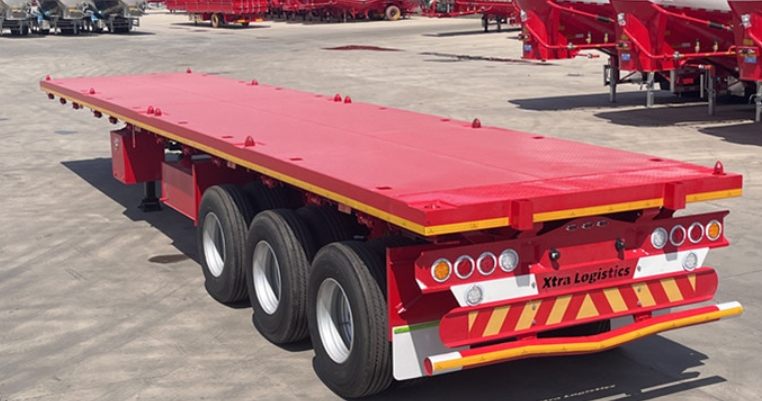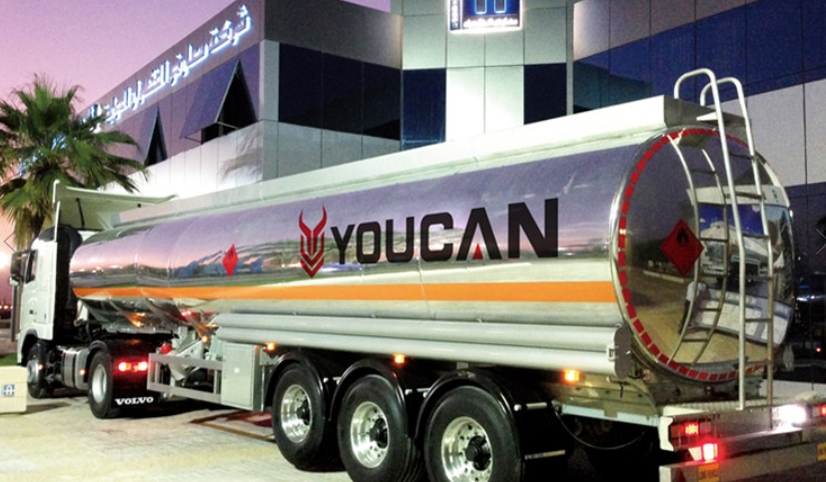How To Transport Cargo On A Standard Flatbed Trailer
What is a standard flatbed trailer
A standard flatbed trailer is a special vehicle that is usually used to tow or transport vehicles such as cars and motorcycles. The characteristic of a flatbed trailer is that it has a long, wide and flat cargo platform at the bottom of the trailer, on which a disabled vehicle or other cargo can be placed for towing and transportation.
Dimensions
The dimensions of standard flatbed trailers vary according to national and regional standards. Generally, these trailers are divided into several sizes:
Length: The length of a common flatbed trailer is between 40 feet and 53 feet (12.2 meters and 16.2 meters). The width can be divided into 8.5 feet (2.6 meters) and 102 inches (2.59 meters).
Width: The width of a flatbed trailer is usually between 8.5 feet and 8.6 feet (2.59 meters to 2.6 meters).
Height: The height of the platform part from the ground is usually between 4.9 feet and 5.3 feet (1.5 meters to 1.6 meters).
Structural features
The main structural features of standard flatbed trailers include the following:
Flat loading platform: The main feature of flatbed trailers is their wide and flat loading platform, which is suitable for transporting all kinds of goods.
Removable brackets: In order to facilitate the fixing and removal of goods, some flatbed trailers are equipped with removable brackets on the loading platform.
Two-axle or three-axle structure: Flatbed trailers usually adopt two-axle or three-axle structure to distribute the weight and comply with road regulations in different regions.
Chassis: The chassis of flatbed trailers is designed to be flat, which is convenient for carrying heavy goods.
Braking system: Flatbed trailers have advanced pneumatic braking systems to ensure safety and stability during transportation.
Advantages
Flatbed trailers have the following advantages:
High flexibility: Flatbed trailers can adapt to all kinds of goods, especially those that are extra long, extra wide or specially shaped.
Convenient loading and unloading: Due to the openness of the vehicle structure, loading and unloading is very convenient, which can save a lot of manpower and time.
Reduced transportation costs: Flatbed trailers can carry a large amount of goods and reduce transportation costs.
Stability: Due to the flat and wide chassis design, it has high stability and is relatively stable when driving on the road.
Compatibility: Flatbed trailers can be used with various tractors and have good compatibility.
In short, standard flatbed trailers play an important role in the logistics industry with their long, wide, flat cargo platform, detachable brackets, pneumatic brake system and superior transportation performance. It greatly improves the efficiency and convenience of the transportation process and reduces transportation costs.
How to properly operate a standard flatbed trailer
The process of using a standard flatbed trailer can be broken down into the following main steps:
Ensure safety: Before using a flatbed trailer, make sure you have the correct driver's license to operate a trailer. Inspect your trailer and towing vehicle to ensure they both meet safety requirements. Make sure the trailer has the correct details on it, such as the correct license plate and contact information.
Prepare the towing vehicle: Before connecting the trailer to the towing vehicle, make sure the towing vehicle is parked and the parking brake is engaged. Check the towing vehicle's brakes, lights, steering, and vision for proper operation.
Connect the trailer:
Lower the flatbed trailer to the ground. If the trailer has a manual control, flip the switch to fully lower the trailer to the ground.
Align the towing vehicle with the trailer, then connect the trailer to the tow hook of the towing vehicle.
Inspect the trailer's safety chains and connectors and make sure they are connected strictly in accordance with the manufacturer's specifications.
Test the trailer's electronic wiring to ensure that the brakes, lights, and appropriate turn signals are working properly.
Loading the Towed Vehicle:
Drive the towed vehicle onto the flatbed, making sure the legs are firmly placed on the flatbed to prevent it from shifting.
Make sure the towed vehicle's front wheels are in front of the flatbed's self-locking tow restraints.
Put the towed vehicle into towing mode or put its retarder in the correct mode.
Securing the Towed Vehicle:
Secure the towed vehicle onto the flatbed using tire straps or tie bars.
To ensure a good grip, break the anchor several times and evenly distribute the position on the trailer.
Inspect your trailer and towed vehicle according to the manufacturer's instructions to ensure the connection is correct.
Driving:
Before setting off, check the trailer to ensure that nothing will fall off.
Pay special attention when driving the trailer, as the towing vehicle's braking distance and driving pattern will be affected.
Observe local traffic regulations and speed limits.
Unloading the Towed Vehicle:
After safely stopping, release the towed vehicle's anchors and drive the towed vehicle off the flatbed.
Note: The above steps are intended as a general guide only. Always follow the manufacturer's operating instructions when using and operating a flatbed. In any case, be sure to pay attention to safe operation of the trailer. In addition, the technical personnel driving the trailer and the transportation safety requirements are roughly as follows:
Professional ability requirements
Driving license: Trailer transport personnel should have a suitable driving license, such as a large truck driving license (C1, C2 driver's license).
Related training: Trailer drivers should participate in relevant training courses to understand the professional knowledge of flatbed trailer operation, loading and unloading, maintenance and driving skills.
Safety awareness: Trailer transport personnel must have a certain safety awareness to ensure that they can take effective actions quickly and abide by traffic rules in an emergency.
Technical requirements for transportation process safety
Loading safety: Ensure that the goods are properly fixed on the flatbed trailer to avoid dangerous conditions such as shifting, sliding or falling of goods during transportation.
Vehicle inspection: Before each departure, conduct a vehicle inspection, including the brake system, lighting system, tires, fluid level, etc. to ensure vehicle safety.
Driving behavior: Obey traffic rules, maintain a suitable driving speed and safe distance. At the same time, avoid fatigue driving.
Emergency plan: Develop a corresponding emergency plan. In case of an emergency, contact the relevant department and report the accident immediately. Ensure that the vehicle equipment is equipped with emergency repair tools, fire extinguishers and other safety facilities.
Regular maintenance: Regular maintenance of the flatbed trailer is performed to ensure that the vehicle is in good operating condition.
Application scenarios of ordinary flatbed trailers
Ordinary flatbed trailers are a common road rescue service vehicle used to tow and transport other vehicles. It has a flat and spacious compartment that can accommodate various types of vehicles, such as broken-down vehicles, accident vehicles, illegally parked vehicles, etc. The application of ordinary flatbed trailers mainly includes the following aspects:
Road rescue services:
Daily business of towing companies
Government road rescue services
Accident vehicle handling:
Evacuation of the accident scene
Drag and safe transportation of accident vehicles
Illegally parked vehicle towing away:
Urban law enforcement departments to manage illegal parking
Private parking lot management
Vehicle management for large-scale events:
Temporary traffic control for exhibitions, events and other activities
Timely cleaning of damaged or broken vehicles
Special vehicle transportation:
Safe transportation of special vehicles such as antique cars and luxury cars
Transportation of unique needs such as modified vehicles and broken-down vehicles
Mechanical equipment transportation:
Transportation of construction machinery
Safe transportation services for various types of equipment
Ordinary flatbed trailers have become the preferred vehicles in many fields such as traffic management, public rescue and private business due to their simple structure, easy operation and high carrying capacity.
Flatbed trailer prices
The prices of flatbed trailers vary depending on the brand, model, configuration and load capacity. Generally speaking, the price range may be between 20,000 RMB (about 2,900 USD) and 500,000 RMB (about 7,300 USD). However, the specific price depends on the following factors:
Brand and quality
Used or new
Load capacity and size
Configuration and features (for example, whether there are side panels and/or bumpers)
When purchasing a flatbed trailer, be sure to consider these factors and make a decision based on your own needs and budget. It is recommended that you compare trailers from multiple manufacturers and models before purchasing to find the price and configuration that best suits you.
Suppliers of Standard flatbed trailer
To find the right flatbed trailer supplier, you need to consider your needs and location. YUOCAN is an experienced and professional manufacturer that provides high-quality products and comprehensive after-sales services to many countries around the world. Whether you need to buy a flatbed trailer or seek support in operation, repair and maintenance, choosing this quality supplier will bring you a satisfactory solution.

 WhatsApp
WhatsApp
 sales@youcantrailer.com
sales@youcantrailer.com
 +8615203709888
+8615203709888


